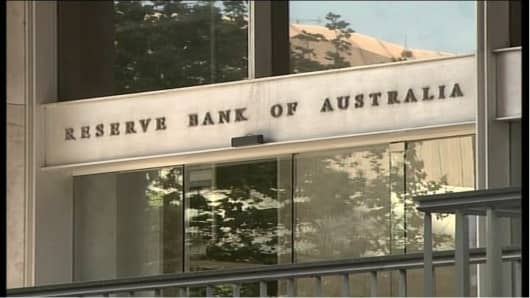In his semi-annual testimony on the economy before lawmakers, Reserve Bank of Australia (RBA) Governor Glenn Stevens cautioned that the outlook was an uncertain one given that the economy had surprised with its strength in the past.
"We do think, however, that demand growth in Australia is now in the process of moderating," said Stevens. "Our assessment is that a change in trend is occurring, and we are hearing that from businesses we talk to."
Analysts took this as the clearest sign yet that the central bank felt it had raised interest rates enough, following hikes in February and March which took the cash rate to a 12-year high of 7.25 percent.
"Stevens confirmed a wait-and-watch stance for the RBA consistent with a likely peak in cash rates at 7.25 percent," concluded Su-Lin Ong, a senior economist at RBC Capital Markets.
The Australian dollar slipped a third of a U.S. cent in the wake of the comments and the soft retail sales report.
Bill futures actually dipped slightly since investors had already priced out pretty much any chance of a further tightening given the deepening global credit squeeze and a dimming outlook for world growth. Indeed, some had hoped Stevens would open the door to a rate cut.
The governor, however, was not so generous.
"I can't tell you at what point rates will start to come down. I can't even promise really that they might not rise again," said Stevens.
Premature
Analysts also felt the market was premature in pricing in rate cuts as early as the end of the year.
"The RBA is on hold with a tightening bias" said Tony Meer, chief economist at Deutsche Bank. "The hurdle to exercising this bias is clearly much larger than it has been the past year, but to see the RBA turn around and easing this year requires a virtual and immediate stalling of the economy," he argued.
Indeed, Stevens warned that consumer price inflation likely hit 4 percent in the first quarter of the year, well above the central bank's 2 percent to 3 percent comfort zone.
Inflation figures for the first quarter are due out on April 23 and should show growing price pressures in petrol, food, rents and financial costs.
In February the central bank forecast inflation would stay at 3.0 percent or higher all the way to mid-2010.
"Since we made those forecasts I think it will come back a bit ... a bit sooner than that," said Stevens. "But I don't think we can credibly say that it will start coming down very quickly very soon."
That left analysts looking at a protracted period of steady monetary policy.
"If the tightening cycle did end in March, the RBA almost certainly will leave the cash rate on hold for an extended period, to make sure the inflation dragon has been slain," said Stephen Walters, chief economist at JPMorgan.


